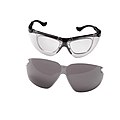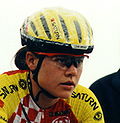This article needs additional citations for verification .(February 2017) |

Eye protection is protective gear for the eyes, and sometimes face, designed to reduce the risk of injury. Examples of risks requiring eye protection can include: impact from particles or debris, light or radiation, wind blast, heat, sea spray or impact from some type of ball or puck used in sports.
Contents
- Styles
- Spectacles
- Goggles
- Welding helmets and shields
- Hoods
- Face shields
- Respirator face pieces
- Protection categories
- Flying objects
- Flying particles, dust, and wind
- Heat, sparks, and splash from molten materials
- UV radiation
- Acid splash; chemical burns
- Abrasive blasting materials
- Glare or stray light
- Injurious optical radiation (Moderate)
- Injurious optical radiation (Severe)
- Other protection
- Helmets and visors
- Gallery
- See also
- References
Eye protection are typically separated into categories based on the style of eye wear and the hazard they are designed to reduce. There categories include: spectacles with side protection; goggles; welding helmet; welding hand shields; non-rigid helmets (hoods); face shield; and respirator face pieces.



















